History
The story begins in 1945 with the launch of a summer art exhibition by Southwold and District Art Group in the old Drill Hall. (This was later to become the Conservative Hall) Subsequently the exhibition moved to the large ground-floor room at the Homestead on South Green. This building had originally been a shop. Today it has been converted into apartments. In 1961, the exhibition moved back to the Drill Hall.
In 1966, the activities of the Art Group, including the exhibitions, were taken over by the Southwold Art Circle which had been founded in 1960. The Summer Exhibition which the newly combined society held that year was the first of an unbroken line stretching to the present day.
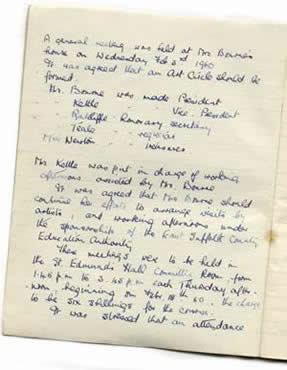
Minutes of the founding meeting of the Art Circle on Feb 3 1960.
A general meeting was held at Mrs Bourne's house on Wednesday Feb 3rd 1960. It was agreed that an Art Circle should be formed.
Mrs Bourne was made President, Mrs Kettle, Vice President, Mrs Ratcliffe, Honorary Secretary, Mrs Teale, Registrar, Mrs Newton, Treasurer.
Mrs Kettle was put in charge of working afternoons assisted by Mrs Bourne. It was agreed that Mrs Bourne should continue her efforts to arrange visits by artists, and working afternoons under the sponsorship of the East Suffolk County Education Authority.
These meetings were to be held in the St. Edmund's Hall Committee Room from 1.45 to 3.45 each Thursday... the charge to be six shillings for the course ... It was decided to ask Captain Russell, Mr Benner and Mr Baldwin as the visiting artists.
In August 1967 the selection committee, as reported in the local newspaper, comprised Alwin Adcock, Kenneth Cuthbert, Richard Constable, Guy Nichols and Peggy Somerville. The panel were each allowed to enter three pictures of their own, free of payment of the 2/6d entrance fee. Prices were mainly around 30 guineas with Peggy Somerville's River in Suffolk commanding a small premium at 35 guineas.

The Art Circle possesses an archive of documentation, including committee minutes, exhibition catalogues etc dating back to 1960.

1967 Committee pictured with the Mayor and Mayoress, Mr and Mrs N.C. Field, at the opening of the Art Circle's Summer Exhibition.
Nancie Pelling (1920 - 2008), trained at Ipswich School of Art and later teacher of art at St Felix School, had this to say:
When I first exhibited with the Southwold and District Art Group in 1956, exhibitions were held at The Homestead. At that time there was no rule that exhibitors had to be members and, for several years, I exhibited even though I was not a member.
In the early 1960s, Mrs Christina Whitehead, who was Chairman of the Art Group, persuaded me to join. A few years later she asked me if I would be willing to stand as the first President of the Southwold Art Circle. I suppose that, as I taught art at St Felix School, she decided that I was suitably qualified! I was elected and continued in that role until December 1968 when I was struck down by meningitis.
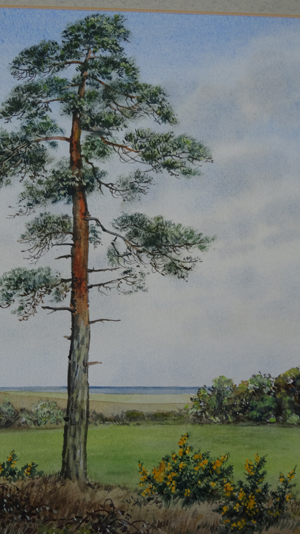
Scots Pine, Reydon, Nancie Pelling, 1997

Summer 1968 Committee members left to right: Joan Gordon, Kath Jenkins,Christina Whitehead, Mr and Mrs Field (Mayor and Mayoress), Nancie Pelling, Mrs N. Jackson, Mr Whitney, Mr and Mrs Taphouse and Mrs N. Wigram.
Note on Southwold Art Circle Annual Awards:
Christina Whitehead Award for an oil painting, Christina Whitehead Award for a work in media other than oils: Christina Whitehead died early in 1970 and Nancie Pelling proposed to the committee that a memorial to her be organised funded by subscriptions. The fund grew to such an extent that, by August that year, it was decided to endow two annual awards in Christina Whitehead's name, one for oils, one for other media. The awards were to be inscribed silver salvers to be held for one year They are awarded to this day and now also include a cash prize.
Sylvia Frere-Smith Award for a watercolour: A donation of £100 was made to the Art Circle in 1979 by Mr Frere-Smith in memory of his mother Sylvia. He expressed the wish that it be used to endow an award for a Watercolour. The Award, an Armada Plate, continues to be made annually.
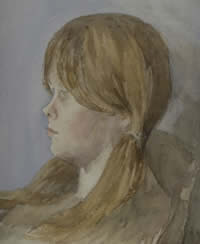
A watercolour portrait by Christina Whitehead, priced at £2 and purchased by Mrs Wendy Sinclair (Reproduced by kind permission of Mrs Sinclair)
The committee at that time, according to Nancie:
Joan Gordon was Secretary, later succeeded by Kath Jenkins who held the post for many years. Mrs Scudamore was Treasurer and after her it was Victor Stanyon whose wife, Gwen was a most accomplished artist. Then there were Mr and Mrs Taphouse who lived in Church Street, Miss Peggy Ottley of Hotson Road, daughter of the Headmaster of St. Felix School, Mr Whitney... Nadina Wigram was a later arrival; she lived in Beacon Cottage... and finally Mrs N. Jackson, another Hotson Road resident.
Clifford Russell, an architect who lived at Grove Farm, Frostenden, was exhibiting in those early days. He was still exhibiting until shortly before his death. Jack Denny (brother of Noreen) of Denny the tailor in Southwold Market Place, played an important role in the Art Circle back in the 1950s.
Colonel & Mrs Monier-Williams were instrumental in introducing the rule that only members of the Art Circle should be entitled to exhibit.
Frank Forward and William Benner (whose oils of the Southwold Railway hang in the Southwold Museum) were well-known artists exhibiting in the early days, as was Chris Sinclair.
Simon Loftus, former Chairman of Adnams PLC, recalls both Frank Forward and Clifford Russell.
"Frank Forward I briefly remember from my childhood, when he was employed to give me a few drawing lessons. Other than that I have a feeling that he may have painted a portrait of my grandfather, PC Loftus. As far as Clifford Russell is concerned, I know that he was a friend of my father and that he was blown up in a tank during the war, I think in North Africa, and thereafter lived and worked in a wheelchair."
Russell went on to qualify and practise as an architect and, among his many assignments was the conversion of a number of Adnams pubs, including the Anchor at Walberswick.
Chris and Wendy Sinclair moved to Walberswick in 1960. They had met at Wimbledon School of Art in the '50s and both went on to the Slade where they gained diplomas in Fine Art. "My parents lived in Halesworth, which was one reason that we settled here," explains Wendy. "In fact, I had been exhibiting with the Southwold Art Group since its early days."
Money was a problem so, to make ends meet, Chris took a job as a nursing orderly at Blythburgh Hospital. Before he died in 2012 Chris commented on this period of his career:
At least it left me mentally free to concentrate on my painting on the three days a week that I was not at the hospital. I also started teaching sessions with the Southwold Art Group which had an active educational role subsidised by the Council.
The Matron of Blythburgh Hospital kindly arranged for me to have every Wednesday off in term time. I also taught an adult evening class in Walberswick, also under the auspices of the Council. Richard Scott's mother was the main instigator of this class.
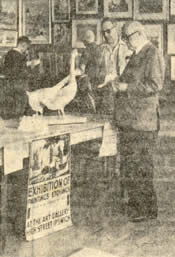
Southwold & District Annual Summer Art Exhbition in 1955. The venue in those days was the Homestead on South Green and the much admired Chinese Geese, sculpted in plaster, were by Miss Wendy Besley (later Sinclair). "There was no selection in those days and you didn't even have to be a member. The organisers were always delighted to receive anything. The idea of a selected exhibition started a few years later when the number of exhibitors had grown so much we had to move to the Conservative Hall."
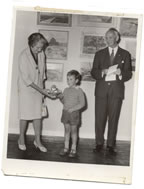
Young Peter Sinclair, second son of Chris and Wendy, presenting Mrs Field, the Mayor's wife, with a box of chocolates at the summer exhibition, probably in 1965.
An important 'outlet' for local artists at that time was the gallery run by Miss Iris Birtwistle in converted chicken houses in her garden at Millfield House. Chris and Wendy exhibited here alongside several well known names in the art world. Iris Birtwistle had to sell up and move on when neighbours objected to the disruption caused by the many cars owned by visitors to the galleries.
Richard Scott was President of Southwold Art Circle for many years. He is the author of 'Artists at Walberswick: East Anglian Interludes 1880 - 2000' and 'Walberswick Enigma: Artists inspired by the Blyth Estuary'. A professional artist himself, he has always lived in the area and his memories of the Art Group (later Art Circle) go back to his boyhood.
My first recollection of the summer exhibitions was in the early 1950s when I was home for school summer holidays and the show was at the Homestead. The star turns at that time were Frank Forward (c.1901 -1974) who had studied at the Slade, and Frederick Baldwin (1899 - 1984), a self-taught but extremely successful watercolourist, Clifford Russell (1919 - 2003) and my father, Eric Scott (1904 -1960).
Baldwin and my father were known at that time for their railway carriage panels (those long-landscape-format pictures under the compartment luggage racks)
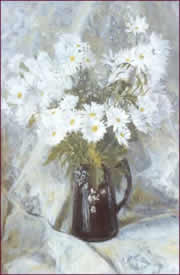
"White chrysanthemums", an award-winning work by Wendy Sinclair dating from the early 1970s - a rare study of cut flowers from an artist better known for painting growing plants.

"Beach at Walberswick" by Chris Sinclair, painted circa 1969 when freak summer weather conditions caused sandbanks to form an enclosed lagoon.
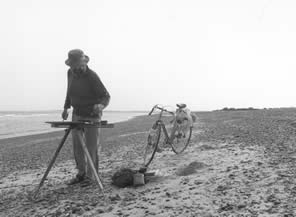
Chris Sinclair pictured painting 'en plein air' on the beach at Walberswick in the early 1980s.
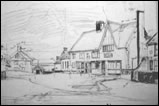
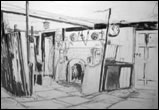
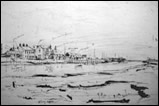
Drawings by Eric Scott. From left: "The Bell, Walberswick", c1952, "Bar Parlour, Bell Inn" c1952, "Blackshore", a working drawing c1951
William Benner (1884 - 1964) was a major figure, too: he had a studio beside the A12 at Blythburgh (the building is still there.) Wendy Sinclair used to see him cycling off for a day's painting on a tall 'policeman's' bike with all his equipment efficiently lashed to it. She always thought he dressed like a schoolmaster - always with tweed jacket and tie.
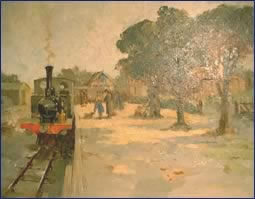
A William Benner oil of the Southwold Railway (reproduced by permission of Southwold Museum).
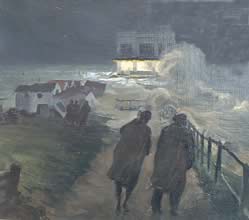
Frank Forward started painting this oil of the disastrous 1953 flood at Southwold on the night it happened, based on his first-hand experience.(reproduced by permission of Southwold Museum).
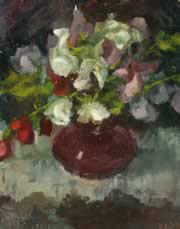
Sweet Peas, Richard Scott's first recorded work completed when he was 15.
Like Chris Sinclair, Richard was persuaded to teach local authority-sponsored evening classes in the early 1970s. Although open to all, the classes were dominated by Art Circle members. He particularly recalls an elderly lady student, Mrs Jackson, married to a Methodist minister and even then in her eighties.
"One day we all went out on a 'field trip' and the idea was that I would demonstrate the process of beginning a landscape painting in oils. I had set up my easel at the base of a steep bank and the students had arranged themselves on the bank itself for a good view of the canvas. Mrs Jackson hadn't noticed that two of the legs of the stool she was sitting on were gradually sinking into the soft earth. The inevitable happened and I turned round just in time to see her somersaulting down the bank to land, literally on my palette. Undaunted, she straightened herself out, covered in mud and paint, climbed upon the tall bike she liked to use and cycled off. Half an hour later she was back, with a complete change of clothes, just in time to see me finishing the painting. She was a remarkable lady and I seem to remember she was still an active Art Circle member into her 90s."
Richard Scott twice sat on the Summer Exhibition selection committee in the '70s - once with the redoubtable local artist, Peggy Somerville and on an even more memorable occasion, with Richard Parsons, head of Lowestoft Art School and a one-time President of the Art Circle.
"In those days, the selection process was more formal than today. The selectors sat in a row and the pictures were held up one at a time for their consideration - a bit like the RA Summer Exhibition. Dick Parsons was a delightful man whom I had never heard express an unkind word about anyone - which made his behaviour on this occasion especially startling.
As the pictures were displayed, Dick became increasingly uninhibited and articulate in his appraisals - I think, quite forgetting that, in many cases it was the artists themselves holding the works proudly aloft.There were a few rather tense moments.
Over the years, the Circle has become much more approachable and less formal. I remember it in the early days as having a somewhat impenetrable quality. It is a much larger society now and the range styles and subject matter is much wider. On the whole I think the quality of work is higher now. Traditional landscapes are, perhaps, the exception: there are far fewer exhibited now and I think many of them lack the richness and technical competence of those I remember in my youth."
Mona Thomson joined the Art Circle in 1976, was appointed to the committee in 1981 and was chairman for 18 years, from 1983 to 2001. She died in 2011. During her chairmanship she experienced many changes. In 1983, Sir George Robinson was President. When he died in 1985, Jack Denny - then Vice President - took over, followed by Richard Parsons, Richard Scott and then Jack Stephenson. "They all brought with them their professional skills and their contributions have played a very important part in the development of the Art Circle," said Mona.
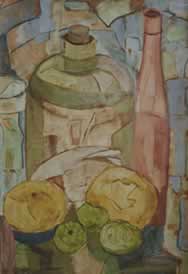
A year after joining the Circle, Mona exhibited the pastel above - 'Bottles with Shapes'- at the Summer Exhibition 1977.

'The Lighthouse', a Mona Thomson silkscreen print which won theChristina Whitehead award for media other than oils in the Summer Exhibition of 1985.
"Following the death of Sir George Robinson, we received, in 1987, a gift of £500 from Lady Robinson and also, in the same year, £500 from Mr Alan Turner in memory of his wife Prudence. These gifts were originally intended to fund new awards for the summer exhibition. But, as we already had three, it was decided to put the money into a special account in the Bank and divide the interest among the winners of the existing awards.
When I joined the Art Circle in 1976 exhibitions were held in the Conservative Hall. It was the only art exhibition in the area and, on the opening day, there were queues reaching from the hall down Woodley's Yard to the High Street. At that time pictures had to be hung from a rail some 10ft high.
In 1985 one of our members, Ronnie Rutherford, a retired architect and very able painter, designed the screens for hanging the pictures. These were made by Eddie Mower and assembled for each exhibition. Southwold-based international furniture removers, Blyth Hasel, generously stored the screens for us without charge. They also undertook to deliver (for a small charge) pictures sold to those living away from the Southwold area.
When the exhibitions moved to Eversley gym in 1991, we used the same screens with a few additions. The Gym was so much larger and lighter, and members were delighted with the move.
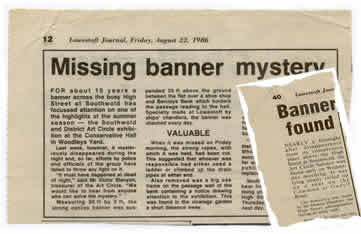
During the 1986 Summer Exhibition, the disappearance of the 30 ft banner from its traditional place above the market square was the talk of the town. It reappeared a fortnight later, neatly rolled up on a bench on the Common. The incident remains an unsolved mystery!
At that time we mounted exhibitions at Easter and in the Summer. However, we experienced some very cold Easters which deterred visitors and caused discomfort to invigilators. When we later transferred this exhibition to Buckenham House, we decided to reschedule it to the autumn. Buckenham House proved so popular that members wanted the summer exhibition there as well. An Extraordinary General meeting was held to canvas members' views and there was an overwhelming vote (including a postal vote) for the move. This new arrangement lasted only 2 years as we were no longer able to rent the Gallery space. We moved back to Eversley Gym in 1999.When the gym was sold to developers exhibitions transferred to Southwold Primary School for a few years."
Today the summer exhibition is held in the Scout Hall. Monthly lectures continue to be given on all aspects of art, academic, historical and practical. Until her death in 2012 Eve King, formerly of the Courtauld Institute, drew record crowds for her entertaining and erudite talks on artists, given without notes and illustrated with slides from her unique personal collection.

The 1988 Summer Exhibition Catalogue was the first to sport the Art Circle logo, designed by Robert Strand and still in use today.
For many years the life group met weekly for three terms a year. It was started in 1984 by Ann Ainscough who said "no art group should be without one". Monthly workshops started with screenprinting in 1988 and offered opportunities to work in a wide variety of media. For many years a portrait and figure drawing group has proved popular. They used to meet weekly in the Guide Hut.
With grateful acknowledgment to Barry Tolfree who researched and wrote this history for our first website.